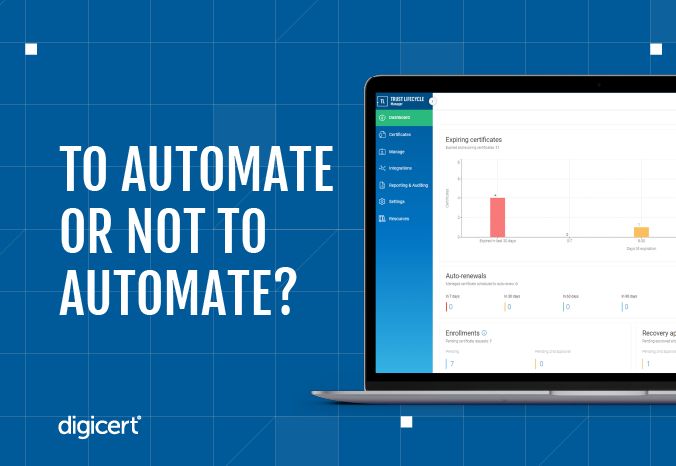
These days, automation is everywhere.
Robotaxis shuttling passengers to the airport. Robotic harvesters plucking fruit from the vine. Artificial intelligence (AI) interpreting the results of X-rays and MRIs.
We’ve automated our homes—refrigerators taking stock of what’s on the shelves and suggesting recipes. Robotic vacuums mapping the layout of our floors. Irrigation systems monitoring the weather and soil moisture to keep the lawn healthy without wasting water.
Since cybersecurity has always existed within the digital space, it's a given that automation is also happening here. In fact, there’s never been a better time to automate digital security.
But that doesn’t mean automation is right for every task. Some things are better left in the hands of humans.
So how do you decide which manual processes to automate within digital security and which to leave as-is? We’ve put together a guide to certificate management automation to help you out.
Why you should automate certificate management
Certificate management is the perfect place for automation. That’s not just because automating your day-to-day tasks makes life easier—automated certificate management is a boon to security, too.
Why? For one thing, the number of digital certificates is exploding, which amplifies the risk of a certificate-related outage. These outages don’t just cost businesses lost revenue. They can also be incredibly damaging to a company’s reputation and may even lead to compliance fines and legal repercussions.
Certificate lifespans have also gotten shorter, making them harder to track with a spreadsheet. Web threats become more sophisticated by the day, and quantum computing could start breaking algorithms within the next few years.
What to automate
Your first targets for automation should be repetitive tasks that require significant human management but not a lot of decision-making. Time-sensitive tasks that still need to get done when you’re out on leave are also prime for automation.
In general, you’ll want to automate updates and tasks that are:
- Repetitive and manual
- High-volume
- Prone to human error
- Dependent upon several people
- Time-sensitive
- Audit-sensitive
Which certificate management tasks to automate
Here’s a helpful breakdown of the certificate management tasks that can benefit from automation.
Requests and renewals
Renewing or requesting new certificates is a tedious process. Automating the process doesn’t just save time—it eliminates the headache of manually tracking certificates and helps you avoid unplanned outages. Automation will wind up saving your organization thousands of staff hours every year, boosting productivity and freeing up IT team members for more strategic initiatives.
Validation and approval
Digital certificate validation is the process of verifying a domain, organization, or individual. Pre-validation and automated certificate renewals make future certificate issuance and renewals almost instantaneous.
Alerts
You can stay up to speed on certificate management by automating alerts for certain events. Alert automation enhances security, reduces human error, prevents service disruptions, improves scalability, and helps you stay compliant.
Visibility and reports
The right discovery tools make it easy to find potential risks or vulnerabilities in your network. As you uncover these issues, automating certificate renewals and installation can help resolve network vulnerabilities quickly and efficiently. This doesn't just protect against attacks—it demonstrates a proactive approach to security that earns customer trust and protects your bottom line.
Revocation
Quickly revoking and replacing certificates that have been mis-issued is essential to ensuring certificate integrity. An automatic revocation solution simplifies the process of identifying required certificate revocations and automatically schedules revocation for all impacted certificates.
Integration with other platforms
Integrating certificate management into a single platform simplifies workflows and makes it easier to find information through ACME URLs and APIs.
At DigiCert, for example, it's easy to integrate certificate automation into your existing systems using APIs via the REST protocol. You’d then be able to do things like:
- Integrate certificate ordering into your web development platform;
- Embed certificate lifecycle management into your helpdesk infrastructure; and
- Add automatic certificate renewal to your apps or products.
DigiCert also has pre-configured sensors available through its platforms for direct integration to multiple providers. This common sensor interface is designed for flexibility, allowing automation on load balancers and other systems.
Code signing
Automated code signing helps ensure your development processes move quickly, even with a smaller staff. With a code signing manager, you can:
- Automate code signing with built-in API integration; and
- Pre-plan and approve signature windows for secure releases and updates.
And if you use a solution like DigiCert Software Trust Manager, PKI security will be automated and managed across CI/CD pipelines. This includes automatically signing packages, binaries, and containers during each merge to the master branch when authorized, driving integrity and trust in products and infrastructure.
Which certificate management tasks aren’t suitable for automation?
You might be tempted to try automating every aspect of digital certificate management. But certain elements still require human intervention. Here’s a good rule of thumb: If a task requires key decisions and those decisions will determine how the task is performed, don't automate.
These certificate-related tasks are all best left in the hands of a capable human.
Customer support
Customers can tell the difference between genuine support and automated phone calls or chat responses. Even at DigiCert, where we sing automation’s praises every day, our award-winning support staff is available 24/7, 365 days a year.
Low ROI tasks
Automating any task, even a simple one, involves an initial investment. Then, the team has to invest time into learning the automation tool and configuring the process. For this reason, automation for tasks with a low return on investment (ROI) usually isn’t worth it—low-volume, one-time projects are generally better completed by hand.
Highly complex processes
Certain complex processes would be too complicated to automate. You’ll lose the efficiency offered by automation for anything that requires decision-making and multiple rounds of approvals.
How long can you wait to automate?
Here’s the short answer: You can’t. If you haven’t yet invested in certificate management automation, your organization is already falling behind.
One of the biggest reasons is one we’ve already mentioned: quantum computing. There’s no question that cryptographically relevant quantum computers (CRQCs) will be able to break the traditional asymmetric algorithms our modern security practices are built on—the only question is when.
Becoming crypto-agile by implementing post-quantum cryptography (PQC) can keep your organization safe. But the first step toward making this transition is taking inventory of your certificates, algorithms, and other cryptographic assets. That’s nearly impossible without the right certificate management tools, even for small businesses. But automated certificate lifecycle management puts crypto-agility well within reach.
The latest developments in digital trust
Want to learn more about topics like automation, TLS/SSL certificate management, and post-quantum cryptography? Subscribe to the DigiCert blog to ensure you never miss a story.





